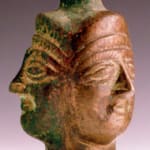Parthian period bronze furniture foot, 200 CE - 400 CE
Bronze
2.5 x 4.75
FZ.189
Parthia is a historical region which roughly corresponds to the north-eastern region of what is nowadays the Islamic Republic of Iran. It was bordered by the Karakum desert in the...
Parthia is a historical region which roughly corresponds to the north-eastern region of what is nowadays the Islamic Republic of Iran.
It was bordered by the Karakum desert in the north, including the mountainous part of Kopet Dag and the Dasht-e-Kavir desert in the south, neighbouring Media on the west, Hyrcania on the north west, Margiana on the north east and Aria on the south east.
The territory of Parthia was conquered and subjugated by the empire of the Medes during the 7th century BC, was eventually incorporated into the subsequent Achaemenid Empire under Cyrus the Great in the 6th century BC, and formed part of the Hellenistic Seleucid Empire following the 4th-century-BC conquests of Alexander the Great. The area later served as the political and cultural base of the Eastern-Iranian Parni people and Arsacid dynasty, rulers of the Parthian Empire (247 BC – 224 AD). The Sasanian Empire succeeded the Parthian Empire as the last state of pre-Islamic Persia, also held the region and maintained the Seven Parthian clans as part of their feudal aristocracy.
The name "Parthia" is a continuation through Latin deriving from the local word Parthava, translated as "of the Parthians" and designating the native inhabitants of the area. Three diademed female faces form the decoration of what very possibly was a foot to the leg on a piece of furniture.
It was bordered by the Karakum desert in the north, including the mountainous part of Kopet Dag and the Dasht-e-Kavir desert in the south, neighbouring Media on the west, Hyrcania on the north west, Margiana on the north east and Aria on the south east.
The territory of Parthia was conquered and subjugated by the empire of the Medes during the 7th century BC, was eventually incorporated into the subsequent Achaemenid Empire under Cyrus the Great in the 6th century BC, and formed part of the Hellenistic Seleucid Empire following the 4th-century-BC conquests of Alexander the Great. The area later served as the political and cultural base of the Eastern-Iranian Parni people and Arsacid dynasty, rulers of the Parthian Empire (247 BC – 224 AD). The Sasanian Empire succeeded the Parthian Empire as the last state of pre-Islamic Persia, also held the region and maintained the Seven Parthian clans as part of their feudal aristocracy.
The name "Parthia" is a continuation through Latin deriving from the local word Parthava, translated as "of the Parthians" and designating the native inhabitants of the area. Three diademed female faces form the decoration of what very possibly was a foot to the leg on a piece of furniture.



